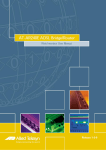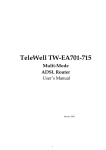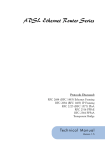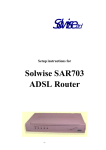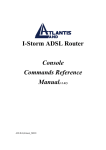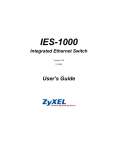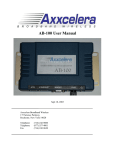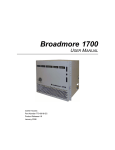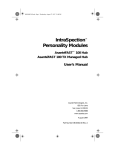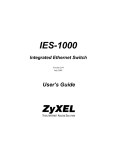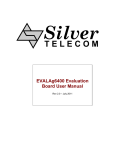Download ZyXEL Communications AES-100 User`s guide
Transcript
AES-100 ADSL-Ethernet Switch August 2001 User’s Guide AES-100 User’s Guide Copyright Copyright © 2001 by ZyXEL Communications Corporation. The contents of this publication may not be reproduced in any part or as a whole, transcribed, stored in a retrieval system, translated into any language, or transmitted in any form or by any means, electronic, mechanical, magnetic, optical, chemical, photocopying, manual, or otherwise, without the prior written permission of ZyXEL Communications Corporation. Published by ZyXEL Communications Corporation. All rights reserved. Disclaimer ZyXEL does not assume any liability arising out of the application or use of any products, or software described herein. Neither does it convey any license under its patent rights nor the patents rights of others. ZyXEL further reserves the right to make changes in any products described herein without notice. This publication is subject to change without notice. Trademarks Trademarks mentioned in this publication are used for identification purposes only and may be properties of their respective owners. ii Copyright AES-100 User’s Guide ZyXEL Limited Warranty ZyXEL warrants to the original end user (purchaser) that this product is free from any defects in materials or workmanship for a period of up to two (2) years from the date of purchase. During the warranty period and upon proof of purchase, should the product have indications of failure due to faulty workmanship and/or materials, ZyXEL will, at its discretion, repair or replace the defective products or components without charge for either parts or labor and to whatever extent it shall deem necessary to restore the product or components to proper operating condition. Any replacement will consist of a new or re-manufactured functionally equivalent product of equal value, and will be solely at the discretion of ZyXEL. This warranty shall not apply if the product is modified, misused, tampered with, damaged by an act of God, or subjected to abnormal working conditions. NOTE Repair or replacement, as provided under this warranty, is the exclusive remedy of the purchaser. This warranty is in lieu of all other warranties, express or implied, inclu ding any implied warranty of merchantability or fitness for a particular use or purpose. ZyXEL shall in no event be held liable for indirect or consequential damages of any kind of character to the purchaser. To obtain the services of this warranty, contact ZyXEL's Service Center for your Return Material Authorization number (RMA). Products must be returned Postage Prepaid. It is recommended that the unit be insured when shipped. Any returned products without proof of purchase or those with an out-dated warranty will be repaired or replaced (at the discretion of ZyXEL) and the customer will be billed for parts and labor. All repaired or replaced products will be shipped by ZyXEL to the corresponding return address, Postage Paid. This warranty gives you specific legal rights, and you may also have other rights that vary from country to country. ZyXEL Limited Warranty iii AES-100 User’s Guide Interference Statements and Warnings FCC Interference Statement: This device complies with Part 15 of the FCC rules. Operation is subject to the following two conditions: (1) This device may not cause harmful interference. (2) This device must accept any interference received, including interference that may cause undesired operations. FCC Warning! This equipment has been tested and found to comply with the limits for a Class A digital device, pursuant to Part 15 of the FCC Rules. These limits are designed to provide reasonable protection against harmful interference in a commercial environment. This equipment generates, uses, and can radiate radio frequency energy and, if not installed and used in accordance with the instruction manual, may cause harmful interference to radio communications. Operation of this equipment in a residential area is likely to cause harmful interference in which case the user will be required to correct the interference at his own expense. CE Mark Warning: This is a class A product. In a domestic environment this product may cause radio interference in which case the user may be required to take adequate measures. Taiwanese BCIQ A Warning: Note and Certifications For more information about your modem’s Declaration of Conformity (DOC) please refer to www.zyxel.com. iv Interference Statements and Warnings AES-100 User’s Guide Customer Support If you have questions about your ZyXEL product or desire assistance, contact ZyXEL Communications Corporation offices worldwide, in one of the following ways: Contacting Customer Support When you contact your customer support representative, have the following information ready: ♦ Product model and serial number. ♦ Firmware version information. ♦ Warranty information. ♦ Date you received your product. ♦ Brief description of the problem and the steps you took to solve it. METHOD LOCATION Worldwide E-MAIL: SUPPORT TELEPHONE WEB SITE SALES FAX FTP SITE [email protected] +886-3-578-3942 [email protected] North Am erica www.zyxel.com www.europe.zyxel.com [email protected] +886-3-578-2439 ftp.europe.zyxel.com [email protected] +1-714-632-0882 www.zyxel.com 800-255-4101 Scandinavia Austria Germany Malaysia Customer Support REGULAR MAIL ZyXEL Communications Corp., 6 Innovation Road II, Science-Based Industrial Park, HsinChu, Taiwan 300, R.O.C. ZyXEL Communications Inc., 1650 Miraloma Avenue, Placentia, CA 92870, U.S.A. [email protected] +1-714-632-0858 ftp.zyxel.com [email protected] +45-3955-0700 www.zyxel.dk [email protected] +45-3955-0707 ftp.zyxel.dk [email protected] +43-1-4948677-0 www.zyxel.at [email protected] +43-1-4948678 ftp.zyxel.at [email protected] e +49-2405-6909-0 www.zyxel.de [email protected] +49-2405-6909-99 ZyXEL Deutschland GmbH. Adenauerstr. 20/A4 D-52146 Wuerselen, Germany. [email protected] +603-795-44-688 www.zyxel.com.my [email protected] +603-795-34-407 Lot B2-06, PJ Industrial Park, Section 13, Jalan Kemajuan, 46200 Petaling Jaya Selangor Darul Ehasn, Malaysia ZyXEL Communications A/S, Columbusvej 5, 2860 Soeborg, Denmark. ZyXEL Communications Services GmbH. Thaliastrasse 125a/2/2/4 A-1160 Vienna, Austria. v AES-100 User’s Guide Table of Contents Copyright .............................................................................................................................................................................................................ii ZyXEL Limited Warranty.................................................................................................................................................................................iii Interference Statements and Warnings ......................................................................................................................................................iv Customer Support .............................................................................................................................................................................................v List of Figures.....................................................................................................................................................................................................x List of Tables.......................................................................................................................................................................................................x Preface................................................................................................................................................................................................................xii Chapter 1 Getting to Know the AES-100.............................................................................................................................................1-1 1.1 Features .............................................................................................................................................1-1 1.2 Benefits.............................................................................................................................................. 1-3 1.2.1 MTU Application ........................................................................................................................1-3 1.2.2 ISP Application ...........................................................................................................................1-4 1.2.3 Compact Design for Limited Space...............................................................................................1-4 1.2.4 Scalable Platform for Future Expansion.........................................................................................1-4 1.3 Physical Specifications ........................................................................................................................1-4 Chapter 2 Hardware Overview...............................................................................................................................................................2-1 2.1 Unpacking the AES-100.......................................................................................................................2-1 2.2 Additional Installation Requirements.....................................................................................................2-1 2.3 Front Panel.........................................................................................................................................2-1 2.3.1 Front Panel Ports.........................................................................................................................2-2 2.3.2 Front Panel LEDs........................................................................................................................2-2 2.4 Console Port .......................................................................................................................................2-2 2.5 ADSL Port Connections .......................................................................................................................2-3 2.6 Rear Panel .........................................................................................................................................2-3 Chapter 3 Software Configuration........................................................................................................................................................3-1 3.1 Command Line Interface...................................................................................................................... 3-1 3.2 Console Connection ............................................................................................................................3-1 3.3 Command Structure ............................................................................................................................3-2 3.3.1 Help Facility................................................................................................................................3-2 3.4 System Commands .............................................................................................................................3-2 vi Table of Contents AES-100 User’s Guide 3.4.1 Uptime Command....................................................................................................................... 3-2 3.4.2 Version Command ...................................................................................................................... 3-2 3.4.3 Restart Command........................................................................................................................ 3-3 3.4.4 Passwd Command ....................................................................................................................... 3-3 3.4.5 Config Print Command................................................................................................................ 3-3 3.4.6 Config Save Command................................................................................................................ 3-3 3.4.7 Exit Command ............................................................................................................................ 3-3 Chapter 4 ADSL Configuration............................................................................................................................................................. 4-1 4.1 ADSL Standards..................................................................................................................................4-1 4.2 Configured Vs. Actual Speed................................................................................................................4-1 4.3 Default Settings ...................................................................................................................................4-1 4.4 ADSL Commands ................................................................................................................................4-2 4.4.1 Config Save Command................................................................................................................ 4-2 4.4.2 Disable Port Command................................................................................................................ 4-2 4.4.3 Disable Ports Command .............................................................................................................. 4-2 4.4.4 Enable Port Command................................................................................................................. 4-3 4.4.5 Enable Ports Command ............................................................................................................... 4-3 4.4.6 Linedata Command ..................................................................................................................... 4-3 4.4.7 Lineinfo Command ..................................................................................................................... 4-4 4.4.8 Lineperf Command ..................................................................................................................... 4-5 4.4.9 Linerate Command...................................................................................................................... 4-6 4.4.10 List Port Command ................................................................................................................. 4-6 4.4.11 List Ports Command ................................................................................................................ 4-7 4.4.12 Set Port Command .................................................................................................................. 4-7 4.4.13 Set Ports Command................................................................................................................. 4-7 4.4.14 Show Port Command............................................................................................................... 4-8 4.4.15 Show Ports Command ............................................................................................................. 4-8 Chapter 5 10 Mbps Ethernet Port Configuration .............................................................................................................................. 5-1 5.1 10 Mbps Ethernet ................................................................................................................................5-1 5.2 Default Settings...................................................................................................................................5-1 5.3 Ethernet Commands ............................................................................................................................5-1 5.3.1 Set Duplex Command.................................................................................................................. 5-1 Table of Contents vii AES-100 User’s Guide 5.3.2 Status Command..........................................................................................................................5-1 Chapter 6 Bridge Configuration............................................................................................................................................................ 6-1 6.1 Bridge Port Numbers ...........................................................................................................................6-1 6.2 Port-Based VLAN................................................................................................................................6-1 6.2.1 Default Settings of Port-Based VLAN...........................................................................................6-1 6.3 Bridge Commands...............................................................................................................................6-2 6.3.1 Device Command ........................................................................................................................6-2 6.3.2 Filter Command...........................................................................................................................6-2 6.3.3 Filterage Command......................................................................................................................6-2 6.3.4 Flush Command...........................................................................................................................6-3 6.3.5 Info Command.............................................................................................................................6-3 6.3.6 Status Command..........................................................................................................................6-3 6.4 Port-Based VLAN Commands.............................................................................................................. 6-3 6.4.1 Portfilter Command .....................................................................................................................6-3 Chapter 7 IP Configuration .....................................................................................................................................................................7-1 7.1 Setting the IP Address.........................................................................................................................7-1 7.2 General IP Commands ........................................................................................................................7-2 7.2.1 Config Command ........................................................................................................................7-2 7.2.2 Ping Command ............................................................................................................................7-3 7.2.3 Statistics Command .....................................................................................................................7-3 7.2.4 Version Command .......................................................................................................................7-3 Chapter 8 Remote Management............................................................................................................................................................ 8-1 8.1 Management by Telnet ........................................................................................................................8-1 8.2 SNMP Management ............................................................................................................................8-1 8.2.1 Supported MIBs...........................................................................................................................8-2 8.3 SNMP Access Configuration ................................................................................................................8-2 8.3.1 SNMP Access Read/Write Command............................................................................................8-2 8.3.2 SNMP Access Delete command ....................................................................................................8-3 8.3.3 SNMP Access Flush Command ....................................................................................................8-3 8.3.4 SNMP Access List Command.......................................................................................................8-3 8.4 SNMP Trap Configuration ....................................................................................................................8-3 8.4.1 Supported Traps...........................................................................................................................8-3 viii Table of Contents AES-100 User’s Guide 8.4.2 Trap Add Command.................................................................................................................... 8-5 8.4.3 Trap Delete Command................................................................................................................. 8-5 8.4.4 Trap Flush Command.................................................................................................................. 8-5 8.4.5 Trap List Command .................................................................................................................... 8-5 Chapter 9 Configuration Backup/Restore.......................................................................................................................................... 9-1 9.1 Configuration Files of the AES-100 .......................................................................................................9-1 9.2 Control Files Used In TFTP Operation ..................................................................................................9-1 9.3 Configuration Backup ..........................................................................................................................9-2 9.4 Configuration Restore..........................................................................................................................9-2 Chapter 10 Firmware Upload .................................................................................................................................................................10-1 10.1 BOOTP/TFTP Firmware Update of the AES-100.............................................................................. 10-1 10.2 TFTP Firmware Update on the AES-100 .........................................................................................10-5 Chapter 11 Troubleshooting ..................................................................................................................................................................11-1 11.1 ADSL LED(s)................................................................................................................................. 11-1 11.2 Data Transmission......................................................................................................................... 11-1 11.3 ADSL LED(s) turn On and Off......................................................................................................... 11-2 11.4 Data Rate...................................................................................................................................... 11-2 11.5 Configured Settings ....................................................................................................................... 11-2 11.6 Password ...................................................................................................................................... 11-3 11.7 Remote Server .............................................................................................................................. 11-3 11.8 SNMP........................................................................................................................................... 11-3 11.9 Telnet............................................................................................................................................ 11-4 Index......................................................................................................................................................................................................................A Table of Contents ix AES-100 User’s Guide List of Figures Figure 1-1 MTU Application..........................................................................................................................................................................1-3 Figure 1-2 ISP Application.............................................................................................................................................................................1-4 Figure 2-1 AES-100 Front Panel ...................................................................................................................................................................2-2 Figure 2-2 AES-100 Rear Panel AC Power Version ..................................................................................................................................2-3 Figure 2-3 AES-100 Rear Panel DC Power Version ..................................................................................................................................2-3 Figure 2-4 Connecting the Power Cord to the AES -100 and a Power Source.......................................................................................2-4 Figure 6-1 Default VLAN Settings ...............................................................................................................................................................6-2 Figure 6-2 Example of Modified VLAN Port 1..........................................................................................................................................6-5 Figure 6-3 Example of Modified VLAN Port 2..........................................................................................................................................6-5 Figure 6-4 Example of Modified VLAN Port 3..........................................................................................................................................6-6 Figure 6-5 Example of Modified VLAN Settings ......................................................................................................................................6-6 Figure 7-1 Setting IP Address and Default Gateway .................................................................................................................................7-2 Figure 8-1 SNMP Management Model ........................................................................................................................................................8-2 Figure 10-1 BOOTP/TFTP Server ..............................................................................................................................................................10-2 Figure 10-2 Input MAC.................................................................................................................................................................................10-3 Figure 10-3 Database Edit Dialog ...............................................................................................................................................................10-4 Figure 10-4 Enable BOOTP/TFTP..............................................................................................................................................................10-4 Figure 10-5 Enter Debug Mode ...................................................................................................................................................................10-4 List of Tables Table 2-1 Front Panel Ports of an ADSL Network Module......................................................................................................................2-2 Table 2-2 AES-100 Network Module LED Descriptions ..........................................................................................................................2-2 Table 4-1 ADSL Standards.............................................................................................................................................................................4-1 Table 11-1 Troubleshooting the ADSL LED(s) ........................................................................................................................................11-1 Table 11-2 Troubleshooting Data Transmission........................................................................................................................................11-1 Table 11-3 Troubleshooting a Non-Constant ADSL LED ......................................................................................................................11-2 Table 11-4 Troubleshooting the SYNC -rate ..............................................................................................................................................11-2 Table 11-5 Troubleshooting the AES-100’s Configured Settings..........................................................................................................11-2 Table 11-6 Troubleshooting the Password .................................................................................................................................................11-3 Table 11-7 Troubleshooting a Remote Server ...........................................................................................................................................11-3 x Lists of Figures and Tables AES-100 User’s Guide Table 11-8 Troubleshooting the SNMP Server .........................................................................................................................................11-3 Table 11-9 Troubleshooting Telnet..............................................................................................................................................................11-4 Table of Contents xi AES-100 User’s Guide Preface Congratulations on your purchase of the AES-100 ADSL-Ethernet Switch. This preface introduces you to the AES-100 and discusses the organization and conventions of this user’s guide. It also provides information on other related documentation. About the AES-100 The AES-100 is an ADSL (Asymmetrical Digital Subscriber Line) to Ethernet switch. It allows you to multiplex traffic from up to 16 ADSL lines to an Ethernet network before it is forwarded to the Internet. General Syntax Conventions “Enter” means for you to type one or more characters and press the carriage return. “Select” or “Choose” means for you to select one from the predefined choices. For brevity’s sake, we will use “e.g.” as shorthand for “for instance”, and “i.e.” as shorthand for “that is” or “in other words” throughout this manual. Related Documentation Support Notes More detailed information about the AES-100 and examples of its use can be found in the Support Notes accessible through the ZyXEL web pages at www.zyxel.com. ZyXEL Web Page and FTP Server Site You can access release notes as well as firmware upgrades at ZyXEL web and FTP sites. Refer to the Customer Support page for more information. xii Lists of Figures and Tables AES-100 User’s Guide Chapter 1 Getting to Know the AES-100 This chapter describes the key features, benefits and applications of your AES-100. The AES-100 is an ADSL (Asymme trical Digital Subscriber Line) to Ethernet switch. It aggregates traffic from up to 16 ADSL lines to Ethernet. ADSL allows the coexistence of broadband data service and conventional voice service over the same telephone wire. When deployed together with ZyXEL’s ADSL modems, e.g., P642M, and WAN routers, e.g., P1400, the combination forms an integrated solution for providing broadband services to multiple tenant units such as apartments, hotels, offices and campus buildings. 1.1 Features Two-Slot Chassis The AES-100 has two slots for the ADSL to Ethernet multiplexer modules. This design provides the flexibility for you to install as few as a single module for the initial deployment and yet still has room to grow as demand increases. 8-Port ADSL to Ethernet Multiplexer Modules Each ADSL to Ethernet multiplexer module aggregates traffic from 8 lines to an Ethernet port. Integrated Splitters The integrated splitters eliminate the need to use external splitters to separate voice-band and ADSL signals. 10 Mbps Ethernet Port This 10 Mbps Ethernet port connects the AES-100 to an Ethernet network. With Ethernet as the backbone, you can create a network that provides ADSL service to hundreds of subscribers. ADSL Compliance • • Multi-Mode ADSL standard § G.DMT (ITU G.992.1) § G.Lite (ITU G.992.2) § G.hs (ITU G.994.1) Rate adaptation support Bridging • IEEE 802.1d transparent bridging Getting to Know the AES-100 1-1 AES-100 User’s Guide • Up to 4096 MAC entries address table Protocol • Multiple Protocols over AAL5 (RFC 1483) Management • Remote configuration backup/restore and firmware upgrade • SNMP manageable • Text-based management locally via console port and remotely via telnet • TFTP (Trivial File Transfer Protocol) for transferring firmware and configuration files Security 1-2 • Password protection for system management • Port-based VLAN Getting to Know the AES-100 AES-100 User’s Guide 1.2 Benefits 1.2.1 MTU Application The following diagram depicts a typical application of the AES-100 is in a large residential building, or multiple tenant unit (MTU), that leverages the existing phone line wiring to provide Internet access to all tenants. A tenant connects a computer to the phone line in a unit using an ADSL modem. The other end of the phone line is connected to a port on the AES-100. The AES-100 aggregates the traffic from the tenants to the Ethernet port and forwards it to a router. The router then routes the traffic further to the Internet. Figure 1-1 MTU Application Getting to Know the AES-100 1-3 AES-100 User’s Guide 1.2.2 ISP Application The AES-100 can also be used by an Internet Service Provider (ISP) as an IP DSLAM. The AES-100 terminates all of the ADSL ATM circuits and converts the traffic to IP packets. All IP traffic goes directly to the ISP’s internal Ethernet network, before being routed to the Internet. Figure 1-2 ISP Application 1.2.3 Compact Design for Limited Space The AES-100 occupies only 1.5 U of standard Telco rack space. Its compactness is perfect for collocation (installation in a central office) and basement installation. Because the AES-100 has built-in POTS splitters, service providers do not have to allocate extra space for POTS splitter shelves. 1.2.4 Scalable Platform for Future Expansion The flexible design of the AES-100 series allows service providers to start with minimum cost. As the number of users and applications increases additional AES-100s can be added to provide greater bandwidth. 1.3 Physical Specifications Physical Interfaces • 1-4 Two network module slots Getting to Know the AES-100 AES-100 User’s Guide • Each network module has eight RJ-11 ports to the CO side and eight RJ-11 ports to the USER side • Each network module has one 10 M Ethernet port • Each network module has one RS-232 console port for local configuration and management Dimensions • In mm: 440 (W) x 320 (L) x 66 (H) Weight • 6.84 kg (two network modules loaded) Power Consumption • 80 watts maximum • 100 - 240 VAC, 50/60 Hz Operating Environment • Temperature: 0 - 50°C; Humidity: 20% - 95% Storage Environment • Temperature: -30 - 60°C; Humidity: 20% - 95% Getting to Know the AES-100 1-5 AES-100 User’s Guide Chapter 2 Hardware Overview This chapter gives a brief introduction to the AES-100 hardware. 2.1 Unpacking the AES-100 Before installing, check to see that all the components of the AES-100 are included in the package. 2.2 Additional Installation Requirements In addition to the contents of the package, you need the following hardware and software components before you install and use your product: • A computer with an Ethernet 10Base-T NIC (Network Interface Card) • WAN service provided by a local phone company • A computer with terminal emulation software configured to the following parameters: 2.3 § VT100 terminal emulation § 9600 bps § No parity, 8 data bits, 1 stop bit § No flow control Front Panel The following figure shows the front panel of the AES-100. Hardware Overview 2-1 AES-100 User’s Guide Figure 2-1 AES-100 Front Panel 2.3.1 Front Panel Ports The following table describes the ports on the front panel of an AES-100 network module. Table 2-1 Front Panel Ports of an ADSL Network Module PORTS DESCRIPTION LAN The LAN port is a 10 Mbps Ethernet port for connection to a router. CONSOLE The CONSOLE port is an RS-232 port for configuring the AES-100. USER 1-8 The USER port connects to the user (subscriber) ADSL equipment. CO 1-8 The CO port connects to the central office or a PBX. 2.3.2 Front Panel LEDs The following table describes the LED indicators on the front panel of an AES-100 network module. Table 2-2 AES-100 Network Module LED Descriptions LED 2.4 COLOR STATUS MEANING LINK Green On Off The LAN port link is up. The LAN port link is down. SYS Green On Off Blinking Your AES-100 Network Module is on and functioning properly. The system is not ready or has a malfunction. The system is initializing. ACT Green Off Blinking The LAN port is not active. Data is being sent. ADSL 1-8 Green On Off The ADSL link is up. The ADSL link is down. Console Port For the initial configuration, you need to use terminal emulator software on a computer and connect it to the AES100 through the console port. Connect the male 9-pin end of the console cable to the console port of the AES-100. Connect the other end (either a female 25-pin or female 9-pin) to a serial port (COM1, COM2 or other COM port) 2-2 Hardware Overview AES-100 User’s Guide of your computer. You can use an extension RS -232 cable if the enclosed one is too short. After the initial setup, you can modify the configuration remotely through telnet connections. 2.5 ADSL Port Connections The line from the user carries both the ADSL and the voice signals. For each line, the AES-100 has a built-in splitter that separates the high frequency ADSL signal from the voice band signal and feeds the ADSL signal to the AES-100, while the voice band signal is diverted to the CO port. To complete an ADSL connection, connect the line fr om the user equipment to the USER port and the line from the central office switch or PBX (Private Branch Exchange) to the CO port. Make sure that the USER line and the CO line are not shorted on the MDF (Main Distribution Frame). 2.6 Rear Panel Make sure you are using the correct power source. The following figure shows the rear panel of the AES -100. Figure 2-2 AES-100 Rear Panel AC Power Version Figure 2-3 AES-100 Rear Panel DC Power Version Hardware Overview 2-3 AES-100 User’s Guide Connect the female end of the power cord to the power receptacle on the rear panel of your AES-100 (just to the right of the warning sticker) as seen next. Connect the other end of the cord to a power outlet. Make sure that no objects obstruct the airflow of the fans (located on the side of the unit). Figure 2-4 Connecting the Power Cord to the AES-100 and a Power Source 2-4 Hardware Overview AES-100 User’s Guide Chapter 3 Software Configuration This section describes the general software configuration of the AES-100 through the command line interface. 3.1 Command Line Interface The AES-100 uses text command lines as the user interface for software configuration. Before discussing the details of configuration, the rules of the commands are listed below. 1. The command keywords are in regular courier font. 2. The command keywords must be entered exactly as shown, i.e., no abbreviations are allowed. 3. The required fields in a command are enclosed in angle brackets (<>), e.g., list port <port number> means that you must specify the port number for this command. 4. The optional fields in a command are enclosed in square brackets ([]), e.g., config [save] means that the field save is optional. 5. “Command” refers to a command used in the command line interface (CI command). Use of commands not documented in this manual is hazardous; you can render the system totally unusable. 3.2 Console Connection For the initial configuration, you must use the console port. After the initial setup, you can telnet to the system to perform additional management tasks. To connect to the console port, use an RS-232 cable to connect the AES100 to a seria l (COM) port of a computer. You can use any terminal emulation program, e.g., Windows’ built-in HyperTerminal, with the following parameters: § VT100 terminal emulation § 9600 bps § No parity, 8 data bits, 1 stop bit • No flow control Software Configuration 3-1 AES-100 User’s Guide 3.3 Command Structure The system uses a two-level command structure. The commands related to one subsystem are grouped under a primary command of that subsystem, e.g., to configure the ADSL parameters, you must first ente r the ADSL subsystem by entering the adsl command. When you are in a subsystem, the system reminds you by including the subsystem name in the command prompt, e.g., 192.168.1.1 adsl > To get back to the top level prompt from a subsystem, use the home command. 3.3.1 Help Facility The system includes a help facility to provide you with online assistance. • You can issue the help or ? command at any time. The system will print a list of available commands in response. • You can issue help with a command name to get more details about it, e.g., > help list The system will respond with the detailed syntax of the list command. 3.4 System Commands The system commands show you the system-related information. They are located on the top level of the two-level command structure. 3.4.1 Uptime Command Syntax: uptime The uptime command shows the elapsed time the system has been running since the last reboot. 3.4.2 Version Command Syntax: version The version command shows the system firmware version. 3-2 Software Configuration AES-100 User’s Guide 3.4.3 Restart Command Syntax: restart The restart command instructs the system to perform a warm start, i.e., restarting the system without turning the power on and off. It is very important that you remember your password. If you forget it, refer to the Troubleshooting section for help. 3.4.4 Passwd Command Syntax: passwd The passwd command changes the management password. The management password is used for authentication at console or telnet login. This command is only allowed for local console management sessions. The management password must be from 1 to 8 characters long and any character is accepted. The factory default password is “1234”. 3.4.5 Config Print Command Syntax: config print The config print command lists all current system configuration settings. 3.4.6 Config Save Command Syntax: config save The config save command saves all system configurations into nonvolatile memory. You must use this command to save any configurations that you make, otherwise the AES-100 will return to its default settings when it is restarted. 3.4.7 Exit Command Syntax: exit The exit command terminates the console or telnet mana gement session. Software Configuration 3-3 AES-100 User’s Guide Chapter 4 ADSL Configuration The ADSL (Asymmetrical Digital Subscriber Line) subsystem allows you to configure and monitor the ADSL ports. 4.1 ADSL Standards The AES-100 supports both the G.lite and the G.dmt standards. G.lite is intended to minimize the cost for the consumer market. Table 4-1 ADSL Standards STANDARD MAXIMUM DOWNSTREAM MAXIMUM UPSTREAM G.dmt 8160 Kbps 1024 Kbps G.lite 1536 Kbps 512 Kbps 4.2 Configured Vs. Actual Speed You configure the maximum speed of the individual ADSL port using the set port command. However, due to noise and other factors on the line, the actual speed may not reach the maximum that you specify. Even though you can specify arbitrary numbers in the set port command, the actual speed is always a multiple of 32 Kbps. If you enter a speed that is not a multiple of 32 Kbps, the actual speed will be the next lower multiple of 32Kbps. For instance, if you specify 60 Kbps for a port, the actual speed for that port will not exceed 32 Kbps, and if you specify 66 Kbps, the actual speed will not be over 64Kbps. Note that when you configure an ADSL port, the upstream speed must be less than or equal to the downstream speed. Note also that the list port command displays the configured parameters of the ADSL port, while the show port command displays the actual speeds. 4.3 Default Settings The factory default settings for all ADSL ports of the AES -100 are - Encapsulation: RFC 1483 - Multiplexing: LLC-based - VPI : 0 - VCI : 33 ADSL Configuration 4-1 AES-100 User’s Guide - Enable/Disable State: disabled - Maximum upstream speed: 512 Kbps - Maximum downstream speed: 2048 Kbps - Operational mode: auto 4.4 ADSL Commands 4.4.1 Config Save Command Syntax: config save The config save command saves the ADSL configuration into nonvolatile memory. 4.4.2 Disable Port Command Syntax: disable port <port number> where <port number> = port number, from 1 to 8 The disable port command forcibly disables the specified ADSL port. The factory default of all ports is disabled. A port must be enabled before data transmission can occur. An enabled but disconnected ADSL port generates more heat than an operating port. To minimize heat generation and to enhance reliability, remember to disable a port when it is not in use. 4.4.3 Disable Ports Command Syntax: disable ports The disable ports command forcibly disables all ADSL ports. The factory default of all ports is disabled. A port must be enabled before data transmission can occur. An enabled but disconnected ADSL port generates more heat than an operating port. To minimize heat generation and to enhance reliability, remember to disable a port when it is not in use. 4-2 ADSL Configuration AES-100 User’s Guide 4.4.4 Enable Port Command Syntax: enable port <port number> where <port number> = port number, from 1 to 8 The enable port command forcibly enables the specified ADSL port. The factory default of all ports is disabled. A port must be enabled before data transmission can occur. An enabled but disconnected ADSL port generates more heat than an operating port. To minimize heat generation and to enhance reliability, remember to disable a port when it is not in use. 4.4.5 Enable Ports Command Syntax: enable ports The enable ports command forcibly enables all ADSL ports. The factory default of all ports is disabled. A port must be enabled before data transmission can occur. An enabled but disconnected ADSL port generates more heat than an operating port. To minimize heat generation and to enhance reliability, remember to disable a port when it is not in use. 4.4.6 Linedata Command Syntax: linedata <port number> where <port number> = port number, from 1 to 8 The linedata command shows the line bit allocation of an ADSL port. An example is shown next. 192.168.1.1 adsl> linedata 7 DS carrier load: number of bits per symbol(tone): tone 0- 31: 0 0 0 tone 32- 63: 0 0 0 22 22 33 33 33 33 33 33 44 33 44 44 44 tone 64- 95: 4 44 44 43 43 33 34 44 33 44 44 34 44 43 33 44 tone 96-127: 44 43 34 44 44 33 43 44 44 34 44 44 33 44 44 44 ADSL Configuration 0 0 0 0 0 0 0 0 0 0 0 0 0 4-3 AES-100 User’s Guide tone 128-159: 44 44 44 34 44 34 43 44 33 43 34 33 33 33 33 34 tone 160-191: 43 33 33 34 34 33 23 33 33 33 22 33 33 33 33 33 tone 192-223: 33 33 33 23 22 33 33 33 23 33 33 33 22 23 22 32 tone 224-255: 22 22 22 22 20 22 22 22 20 0 0 0 0 0 0 0 US carrier load: number of bits per symbol(tone) tone 0- 31: 0 0 0 0 2 34 55 77 88 89 99 99 99 98 88 87 tone 32- 63: 0 0 0 0 0 0 0 0 0 0 0 0 0 0 0 0 The results can determine whether a given sub-carrier loop has sufficient margins to support ADSL data rates, and possibly to determine whether certain specific types of interference or line attenuation exist. The bit allocation contents are only valid when the link is up. 4.4.7 Lineinfo Command Syntax: lineinfo <port number> where <port number> = port number, from 1 to 8 The lineinfo command shows the line operating values of an ADSL port. An example is shown next. 192.168.1.1 adsl> lineinfo 7 Current Operating Modes: Data Mode: ATM Service Type in operation: G.DMT Number of Channels (Down/up stream): 1/1 Downstream Framing Structure : 3 Active down/up stream rate option : 1/1 TRELLIS operation mode is : ON Current Connection detail: Down/up stream interleaved Delay : 4/ 4 ms Downstream Parity byte assigned to fast/interleaved : 0/ 2 Upstream Parity byte assigned to fast/interleaved : 0/ 2 Downstream Symbols assigned to fast/interleaved : 0/ 1 Upstream : 0/ 1 Symbols assigned to fast/interleaved Down/up stream Depth value 4-4 : 2/ 2 ADSL Configuration AES-100 User’s Guide Total Transceiver Output Power : 8dB Current ATUR Information: Country code 0 Provider Code 01020304 Capabilities: g.dmt POTS overlap (Annex A) The results contain the operating modes, interleave delay, parity byte assignment, parity bytes per codeword, symbols per codeword and interleave depth. Current ATUR Information contains data acquired from the ATU-R (stands for ADSL Termination Unit – Remote, in this case the user’s ADSL modem or router) during negotiation/provisioning message interchanges. It includes the Vendor ID and Version Number obtained from Vendor ID fields (g.994.1) or R-MSGS1(T1.413) and country code from Vendor ID (g.994.1). Information obtained prior to training to steady state transition will not be valid or will be old information. 4.4.8 Lineperf Command Syntax: lineperf <port number> where <port number> = port number, from 1 to 8 The lineperf command shows the line performance counters of an ADSL port. An example is shown next. 192.168.1.1 adsl> lineperf 7 nfebe-I/nfebe-ni : 0/0 ncrc-I/ncrc-ni : 0/0 nfecc-I/nfecc-ni : 0/0 nfec-I/nfec-ni : 0/0 nblks-ds/nblks-us : 120878/120878 nsec-ds/nsec-us : 2060/2060 n-eb-ds/n-eb-us : 0/0 n-bbe-ds/n-bbe-us : 0/0 n-es-ds/n-es-us : 0/0 n-ses-ds/n-ses-us : 0/0 non-ses-blks-ds/non-ses-blks-us : 120878/120878 n-uas-ds/n-uas-us ADSL Configuration : 0/0 4-5 AES-100 User’s Guide fe_loss_seconds/ne_loss_seconds : 0/0 fe_fec_seconds/ne_fec_seconds : 0/0 fast_trains : 0 fast_trains_fail : 0 These counts contain line performance data that has been accumulated since the system started. In the list above the definitions of near end/far end will always be relative to the ATU-C. Downstream (ds) refers to data from the ATU-C and upstream (us) refers to data from the ATU-R. 4.4.9 Linerate Command Syntax: linerate <port number> where <port number> = port number, from 1 to 8 The linerate command shows the line rate parameters of an ADSL port. An example is shown next. 192.168.1.1 adsl> linerate 7 Current Active Rates: AS0 downstream rate : 2048 Kbps AS1 downstream rate : 0 Kbps LS0 upstream rate : 512 Kbps LS1 upstream rate : 0 Kbps Down/up stream Margin : 31/22 dB Down/up stream Attenuation : Attainable Dwon/up stream Rate : 11456/ 1344 Kbps 0/ 0 dB These results contain the current downstream and upstream operating values (SHOWTIME) for the requested line, the latest available downstream and upstream margins, channel attenuation and the maximum attainable rate. Downstream and upstream margins must both be at least 6 dB. The initial downstream and upstream margins are first set during training. The upstream margin is recalculated every 15 seconds during “showtime” at the ATU-C and the downstream margin updates every 15 seconds during “showtime” by using EOC messaging. Information obtained prior to training to steady state transition will not be valid or will be old information. 4.4.10 List Port Command Syntax: 4-6 ADSL Configuration AES-100 User’s Guide list port <port number> where <port number> = port number, from 1 to 8 The list port command shows the configured maximum upstream/downstream speeds, the mode (or standard), and enable/disable state of an individual ADSL port. 4.4.11 List Ports Command Syntax: list ports The list ports command shows the configured maximum speeds, modes and states of all ADSL ports. 4.4.12 Set Port Command Syntax: set port <port number> <upstream speed> <downstream speed> <oper mode> where <port number> = Port number ranging from 1 to 8. <upstream speed> = Maximum ADSL upstream speed in Kbps. <downstream speed> = Maximum ADSL downstream speed in Kbps. <oper mode> = Operational mode; the available choices are glite , gdmt or auto. The set port command sets the maximum upstream/downstream speeds and the mode, or standard, of an individual ADSL port. Note that the upstream speed must be less than or equal to the downstream speed. Even though you can specify arbitrary numbers in the set port command, the actual speed is always a multiple of 32 Kbps. If you enter a speed that is not a multiple of 32 Kbps, the actual speed will be the next lower multiple of 32Kbps. For instance, if you specify 60 Kbps for a port, the actual speed for that port will not exceed 32 Kbps, and if you specify 66 Kbps, the actual speed will not be over 64Kbps. The mode parameter specifies the standard that this port is allowed. When set to auto, the AES-100 follows whatever mode is set on the other end of the line. When the mode is set to auto and the negotiated mode is G.lite, if the configured speeds exceed those allowed by G.lite, the actual speeds are governed by G.lite, regardless of the configured numbers. 4.4.13 Set Ports Command Syntax: set ports <upstream speed> <downstream speed> <oper mode> where ADSL Configuration 4-7 AES-100 User’s Guide <upstream speed> = Maximum ADSL upstream speed in Kbps. <downstream speed> = Maximum ADSL downstream speed in Kbps. <oper mode> = Operational mode; the available choices are glite, gdmt or auto. The set ports command sets the same maximum upstream/downstream speeds and the mode, or standard, for all ADSL ports. Note that the upstream speed must be less than or equal to the downstream speed. The mode parameter specifies the standard that the ports are allowed. When set to auto, the AES-100 follows whatever mode is set on the other end of the line. When the mode is set to auto and the negotiated mode is G.lite, if the configured speeds exceed those allowed by G.lite, the actual speeds are governed by G.lite, regardless of the configured numbers. 4.4.14 Show Port Command Syntax: show port <port number> where <port number> = port number, from 1 to 8 The show port command shows the line status (up or down), the actual upstream/downstream speeds and mode of an individual ADSL port. 4.4.15 Show Ports Command Syntax: show ports The show ports command shows the line status (up or down), the actual upstream/downstream speeds and the mode of all ADSL ports. 4-8 ADSL Configuration AES-100 User’s Guide Chapter 5 10 Mbps Ethernet Port Configuration The Ethernet subsystem allows you to configure and monitor the 10 Mbps Ethernet port. 5.1 10 Mbps Ethernet The AES-100 supports 10 Mbps Ethernet. In a 10 Mbps Ethernet, the duplex mode can be half duplex or full duplex. The Ethernet port uses the pre-configured duplex mode setting when making a connection, thus requiring you to check the setting of the peer Ethernet port in order to connect. 5.2 Default Settings The factory default setting for the Ethernet port of the AES-100 is - Half duplex 5.3 Ethernet Commands 5.3.1 Set Duplex Command Syntax: set duplex <mode> where <mode> = full or half The set duplex command sets the duplex mode used. 5.3.2 Status Command Syntax: status The status command shows the current status of the Ethernet port. 10 Mbps Ethernet Port Configuration 5-1 AES-100 User’s Guide 5-2 10 Mbps Ethernet Port Configuration AES-100 User’s Guide Chapter 6 Bridge Configuration The bridge subsystem allows you to configure and monitor the bridging and port-based VLAN functions of the AES-100. The AES-100 supports IEEE 802.1d transparent bridging; but not the static filtering feature or spanning tree protocol. The bridge learns the source MAC addresses of sender hosts by inspecting incoming Ethernet frames and recording the learned MAC addresses with their incoming port numbers into its filtering database. Based on the database, the bridge forwards each incoming frame to its destination port. 6.1 Bridge Port Numbers The bridge subsystem of the AES-100 defines its own numbering convention for ports. The bridge has a total of nine ports; bridge port 1 stands for Ethernet port, bridge port 2 stands for ADSL port 1, bridge port 3 stands for ADSL port 2, and so on. Be sure you have clarified the relation between bridge ports and ADSL ports. 6.2 Port-Based VLAN The VLAN (Virtual LAN) mechanism can be used to limit the broadcast domain to the members of a VLAN group only. Users of one group are not allowed to access the resources of other groups and a higher level of security is achieved. The AES-100 supports port-based VLAN, one type of VLAN implementation. Port-based VLAN requires each incoming port to define its allowed outgoing ports. Ethernet frames are forwarded according to these rules. 6.2.1 Default Settings of Port-Based VLAN The factory default settings for the port-based VLAN of the AES-100 are: - Bridge port 1 (Ethernet port) allowed to all bridge ports - Bridge port 2 (ADSL port 1) allowed to bridge port 1 (Ethernet port) only - Bridge port 3 (ADSL port 2) allowed to bridge port 1 (Ethernet port) only - Bridge port 4 (ADSL port 3) allowed to bridge port 1 (Ethernet port) only - Bridge port 5 (ADSL port 4) allowed to bridge port 1 (Ethernet port) only - Bridge port 6 (ADSL port 5) allowed to bridge port 1 (Ethernet port) only - Bridge port 7 (ADSL port 6) allowed to bridge port 1 (Ethernet port) only - Bridge port 8 (ADSL port 7) allowed to bridge port 1 (Ethernet port) only Bridge Configuration 6-1 AES-100 User’s Guide - Bridge port 9 (ADSL port 8) allowed to bridge port 1 (Ethernet port) only It is recommended that you do not alter these settings, or the AES-100 may not work correctly. The default VLAN settings allow each ADSL port to communicate back and forth with only the Ethernet port, and not with other ADSL ports. The following figure illustrates this. Figure 6-1 Default VLAN Settings 6.3 Bridge Commands 6.3.1 Device Command Syntax: device The device command shows information on all bridge ports. 6.3.2 Filter Command Syntax: filter The filter command displays the filtering database. 6.3.3 Filterage Command Syntax: filterage [age] where age = aging out timer period in seconds 6-2 Bridge Configuration AES-100 User’s Guide The filterage command sets or shows the aging out timer period of the filtering database. It is recommended that you use the default setting. If the time interval is reduced to a setting that is too short, it could increase broadcast traffic and reduce the available bandwidth. 6.3.4 Flush Command Syntax: flush [port] where [port] = bridge port number, from 1 to 9 The flush command flushes out the filtering database of the specified bridge port. If the <port> field is omitted, this command will flush out the filtering databases of all ports. 6.3.5 Info Command Syntax: info The info command shows the software number of the bridge implementation and the maximum size of the filtering database. 6.3.6 Status Command Syntax: status The status command displays the bridge status. 6.4 Port-Based VLAN Commands 6.4.1 Portfilter Command Syntax: portfilter [<source port> all|<dest ports>] where <source port> = incoming bridge port number, from 1 to 9 all = all bridge ports are allowed outgoing ports <dest ports> = the allowed outgoing bridge port number, separate by a space if there is more than one port Bridge Configuration 6-3 AES-100 User’s Guide The portfilter command sets or displays the port-based VLAN configuration. An example is shown next. 192.168.1.1 > bridge 192.168.1.1 bridge> portfilter Port 1 (edd): all Port 2 (bun/port=atm:0/rfc1483=true/txvpi=0/txvci=33/rxvpi=0/rxvci=33): 1 Port 3 (bun/port=atm:1/rfc1483=true/txvpi=0/txvci=33/rxvpi=0/rxvci=33): 1 Port 4 (bun/port=atm:2/rfc1483=true/txvpi=0/txvci=33/rxvpi=0/rxvci=33): 1 Port 5 (bun/port=atm:3/rfc1483=true/txvpi=0/txvci=33/rxvpi=0/rxvci=33): 1 Port 6 (bun/port=atm:4/rfc1483=true/txvpi=0/txvci=33/rxvpi=0/rxvci=33): 1 Port 7 (bun/port=atm:5/rfc1483=true/txvpi=0/txvci=33/rxvpi=0/rxvci=33): 1 Port 8 (bun/port=atm:6/rfc1483=true/txvpi=0/txvci=33/rxvpi=0/rxvci=33): 1 Port 9 (bun/port=atm:7/rfc1483=true/txvpi=0/txvci=33/rxvpi=0/rxvci=33): 1 The above shows the current configuration of the port-based VLAN. It is the same as the default settings. An example with an altered configuration is shown next. 192.168.1.1 > bridge 192.168.1.1 bridge> portfilter 2 1 3 192.168.1.1 bridge> portfilter 3 1 2 This example sets the allowed outgoing bridge ports of port 2 (ADSL port 1) to port 1 (Ethernet port) and port 3 (ADSL port 2). The allowed outgoing bridge ports of port 3 (ADSL port 2) are set to port 1 (Ethernet port) and port 2 (ADSL port1). This way ASDL ports 2 and 3 can communicate with each other and the Ethernet port. You can see the effects of this example by using the following command: 192.168.1.1 bridge> portfilter Port 1 (edd): 6-4 all Port 2 (bun/port=atm:0/rfc1483=true/txvpi=0/txvci=33/rxvpi=0/rxvci=33): 1 3 Port 3 (bun/port=atm:1/rfc1483=true/txvpi=0/txvci=33/rxvpi=0/rxvci=33): 1 2 Port 4 (bun/port=atm:2/rfc1483=true/txvpi=0/txvci=33/rxvpi=0/rxvci=33): 1 Port 5 (bun/port=atm:3/rfc1483=true/txvpi=0/txvci=33/rxvpi=0/rxvci=33): 1 Port 6 (bun/port=atm:4/rfc1483=true/txvpi=0/txvci=33/rxvpi=0/rxvci=33): 1 Port 7 (bun/port=atm:5/rfc1483=true/txvpi=0/txvci=33/rxvpi=0/rxvci=33): 1 Port 8 (bun/port=atm:6/rfc1483=true/txvpi=0/txvci=33/rxvpi=0/rxvci=33): 1 Port 9 (bun/port=atm:7/rfc1483=true/txvpi=0/txvci=33/rxvpi=0/rxvci=33): 1 Bridge Configuration AES-100 User’s Guide The following figures illustrate the above example. Notice that ports 2 (ADSL port 1) and 3 (ADSL port 2) are able to communicate with each other, as well as with the Ethernet. All of the other ports will only be able to communicate with the Ethernet port. This first figure illustrates the first command line. Port 1 (the Ethernet port) is linked to all 8 ADSL ports. Figure 6-2 Example of Modified VLAN Port 1 The following figure illustrates the second command line. Port 2 (ADSL port 1) is able to send to both the Ethernet port and port 3 (ADSL port 2). Figure 6-3 Example of Modified VLAN Port 2 The following figure illustrates the third command line. Port 3 (ADSL port 2) is able to send to both the Ethernet port and port 2 (ADSL port 1). Bridge Configuration 6-5 AES-100 User’s Guide Figure 6-4 Example of Modified VLAN Port 3 This figure illustrates the fact that port 1 (the Ethernet port) is linked to ports 2 (ADSL port 1) and 3 (ADSL port 2). Ports 2 (ADSL port1) and 3 (ADSL port 2) are also linked to each other. Figure 6-5 Example of Modified VLAN Settings 6-6 Bridge Configuration AES-100 User’s Guide Chapter 7 IP Configuration This chapter shows you how to configure the IP (Internet Protocol) parameters. The IP host implementation in the AES-100 allows you to manage it over the network. More often than not, you have more than one AES-100 for a particular installation. Before you start configuring the AES-100s, make sure that you 1. Plan ahead. 2. Have a complete diagram showing the whole network. 3. Record the IP parameters assigned to the equipment in your network. 7.1 Setting the IP Address To set the AES -100’s IP address, subnet mask and default route, use the following command sequence: 1. 192.168.1.1> ip 2. 192.168.1.1 ip> device delete ether 3. 192.168.1.1 ip> device add ether ether //bridge <new ip address> 4. 192.168.1.1 ip> route delete default 5. 192.168.1.1 ip> route add default 0.0.0.0 <default gateway> 00:00:00:00 6. 192.168.1.1 ip> config save 7. 192.168.1.1 ip> restart Line 1 brings you to the IP subsystem. Line 2 clears the old parameters of the AES-100. Line 3 adds the new IP address for the AES-100. The system will automatically compute the subnet mask when the system is restarted. If you want to specify a subnet manually, add the following two commands before line 4: 3.1 192.168.1.1 ip> subnet delete ether.home 3.2 192.168.1.1 ip> subnet add ether.home ether <subnet address> <subnet mask> Where <subnet mask> is the subnet mask in hexadecimal, for example “ff:ff:ff:00”. Line 4 deletes the existing default route. Line 5 adds the new default route. The default route tells the system where the gateway (next hop) is when the AES-100 sends packets to a destination that is not on the same subnet as the AES-100. Line 6 saves the new configuration to the nonvolatile memory. IP Configuration 7-1 AES-100 User’s Guide Line 7 tells the system to restart, in order to make the IP address configuration take effect. The AES-100 does not need to be restarted after configuration of other items. For example, if you want the AES-100 to have 172.21.100.1 as the IP address, 255.255.255.0 for the subnet mask and 172.21.100.254 for the default gateway, you may use the following command sequence: 192.168.1.1> ip 192.168.1.1 ip> device delete ether 192.168.1.1 ip> device add ether ether //bridge 172.21.100.1 192.168.1.1 ip> subnet delete ether.home 192.168.1.1 ip> subnet add ether.home ether 172.21.100.0 ff:ff:ff:00 192.168.1.1 ip> route delete default 192.168.1.1 ip> route add default 0.0.0.0 172.21.100.254 00:00:00:00 192.168.1.1 ip> config save 192.168.1.1 ip> restart Figure 7-1 Setting IP Address and Default Gateway The AES-100 leaves the factory with a default IP address of 192.168.1.1 and a subnet mask of 255.255.255.0, or FF.FF.FF.0 in hexadecimal notation, and the default gateway set at 192.168.1.254. Make sure that you configure the IP parameters correctly before you connect an AES-100 to the network, otherwise, you may interrupt services already running. 7.2 General IP Commands The following is a list of general IP commands that help with the management of the IP parameters. 7.2.1 Config Command Syntax: config [save] This command shows the IP configuration. The save option saves the configuration to the nonvolatile memory. 7-2 IP Configuration AES-100 User’s Guide 7.2.2 Ping Command Syntax: ping <host> [<ttl> [<size>]] This is an IP facility to check for network functionality by sending an echo request to another IP host and waiting for the reply. The host parameter specifies the IP address of the target. The optional ttl (time to live) limits the number of hops (routers) that the echo request can travel before it reaches the target. The size parameter specifies the size of the payload, i.e., not counting the headers, of the echo request; the default size is 32 octets. 7.2.3 Statistics Command Syntax: stats <sub cmd> This command shows the statistics for the traffic of the type specified by the sub-command. Statistics are available for the following traffic types: ARP, ICMP, IP, raw, TCP and UDP. 7.2.4 Version Command Syntax: version This command shows the software number of the IP implementation. IP Configuration 7-3 AES-100 User’s Guide Chapter 8 Remote Management This chapter shows you how to manage the AES-100 remotely. More often than not, you will have the AES-100 located remotely making its remote management very useful. 8.1 Management by Telnet After you have set up the IP parameters and connected the AES-100 to the network, you can manage it remotely with telnet. You can use any telnet client that you find convenient. The configuration procedures with telnet are exactly the same as those using the direct connection via the console port. The default password for a telnet session is “1234”. Although telnet will work while the console port is being used, only one telnet session is allowed at a time. 8.2 SNMP Management SNMP (Simple Network Management Protocol) is a protocol used for exchanging management information between network devices. The AES-100 supports SNMP version 2 agent functionality, which allows a manager station to manage and monitor it through the network. The next figure illustrates an SNMP management operation. Remote Management 8-1 AES-100 User’s Guide Figure 8-1 SNMP Management Model An SNMP managed network consists of two main component types: agents and a manager. An agent is a management software module that resides in a managed device (the AES-100). An agent translates the local management information from the managed device into a form compatible with SNMP. The manager is the station through which network administrators perform network management functions. It executes operations that control and monitor the managed devices. The managed devices contain objects that define each piece of information to be collected about a device. Examples of variables include the number of packets received, node port status, etc. A Management Information Base (MIB) is a collection of managed objects. SNMP allows manager and agents to communicate for the purpose of accessing these objects. SNMP itself is a simple request/response protocol based on the manager/agent model. The manager issues a request and the agent returns responses using the following protocol operations: ♦ Get Allows the manager to retrieve an object variable from the agent. ♦ GetNext Allows the manager to retrieve the next object variable from a table or list within an agent. In SNMPv1, when a manager wants to retrieve all elements of a table from an agent, it initiates a Get operation, followed by a series of GetNext operations. ♦ Set Allows the manager to set values for object variables within an agent. ♦ Trap Used by the agent to inform the manager of some events. 8.2.1 Supported MIBs The AES-100 supports MIB II that is defined in RFC-1213 and RFC-1215 as well as transparent bridge MIBs defined in RFC 1493. The AES-100 can also respond with specific data from the ZyXEL private MIB (ZYXELMIB). 8.3 SNMP Access Configuration To control access to the agent in the AES-100, use the access commands in the SNMP subsystem. Note that “community” is SNMP’s terminology for password. After configuring the SNMP access parameters, save the configuration to the nonvolatile memory with the config save command. The default write community string is “1234”, and the default read community string is “public”. 8.3.1 SNMP Access Read/Write Command Syntax: 8-2 Remote Management AES-100 User’s Guide access <read | write> <community> [<IP addr>] where <read | write> = Specifies read-only/read-write permission. <community> = Password needed to access the SNMP agent on the AES-100. [<IP addr>] = Optional IP address of the allowed SNMP manager. This command allows read-only or read-write access. If the IP address is specified, access is allowed for the manager station with that address only. 8.3.2 SNMP Access Delete command Syntax: access delete <community> [<IP addr>] This command revokes SNMP access by the specified community (password). If the IP address is specified, access is denied for that manager station only. 8.3.3 SNMP Access Flush Command Syntax: access flush This command revokes access by any and all manager stations. 8.3.4 SNMP Access List Command Syntax: access list This command shows the allowed access. 8.4 SNMP Trap Configuration The AES-100 uses the SNMP trapping facility to proactively report unusual events to one or more trap servers. To configure the trap parameters, use the trap commands in the SNMP subsystem. After configuring the SNMP trap parameters, save the configuration to the nonvolatile memory with the config save command. 8.4.1 Supported Traps AES-100 supports the following traps Remote Management 8-3 AES-100 User’s Guide ♦ coldStart Trap (defined in RFC-1215) : This trap is sent at system start-up. ♦ authenticationFailure Trap (defined in RFC-1215) : This trap is sent if a request arrives with an invalid community string. ♦ linkUp Trap (defined in RFC-1215) : This trap is sent when an ADSL port is up. ♦ linkDown Trap (defined in RFC-1215) : This trap is sent when an ADSL port is down. 8-4 Remote Management AES-100 User’s Guide 8.4.2 Trap Add Command Syntax: trap add <community> <IP addr> [<port>] where <community> = The password used by the AES-100 to authenticate itself to the trap server. <IP addr> = The IP address of the trap server. [<Port>] = The optional port parameter is for specifying the UDP port number on the server in case it is different from the default of port 162. This command adds a trap server. 8.4.3 Trap Delete Command Syntax: trap delete <community> <IP addr> [<port>] This command deletes a trap destination. The parameters are the same as the trap add command. 8.4.4 Trap Flush Command Syntax: trap flush This command deletes all trap destinations. 8.4.5 Trap List Command Syntax: trap list This command lists all the trap destinations. Remote Management 8-5 AES-100 User’s Guide Chapter 9 Configuration Backup/Restore This chapter describes the process for backing up your user settings (configuration) from the AES-100 onto your computer and how to restore them to the AES-100. The AES-100 uses TFTP for configuration backup/restore through its built -in TFTP server. You can use any TFTP client to connect to the AES-100. Do not turn off the AES-100 during the updating process, as it may corrupt the firmware and make your AES-100 unusable. 9.1 Configuration Files of the AES-100 The AES-100 uses configuration files to store the user’s settings, so they can be applied the next time the A ES100 is booted. The AES-100 has the following seven important configuration files: initadsl = The configuration file for ADSL ports. resolve = The configuration file for IP parameters. initbridge = The configuration file for bridge settings. password = The configuration file for the console and Telnet password. services = The configuration file for IP services. initether = The configuration file for Ethernet port settings. snmpinit = The configuration file for SNMP settings. 9.2 Control Files Used In TFTP Operation TFTP is a simple file transfer protocol and lacks a password checking feature. The AES-100 requires users to transfer a special file to achieve authentication functions. This file contains the SNMP’s write community string. In addition, there may be more than one configuration file to restore into the AES -100, so it is necessary to tell the AES-100 the beginning and end of the list of configuration files you want to restore. This way the AES-100 can know when to write the restored configuration files to nonvolatile memory. There are three control files used in TFTP operation: tftplock.key = This file contains the SNMP write community string (password). tftpupdt.beg = An empty file (with no content). Acts as a mark of the beginning of the restore process, used only in restoration. tftpupdt.end = An empty file (with no content). Acts as a mark of the end of the restore process, used only in restoration. Configuration Backup/Restore 9-1 AES-100 User’s Guide 9.3 Configuration Backup You can backup all or some configuration files from the AES-100 to your computer. For example, to backup the configuration of ADSL ports and IP settings, the procedure on your computer is as follows: Step 1. Connect to the AES-100 with your favorite TFTP client. The command is generally tftp <AES-100 IP address> at the computer command prompt. Step 2. Set the binary mode. tftp> binary Step 3. Transfer/Get the control file and configuration files to/from the AES-100 tftp> put tftplock.key tftp> get initadsl tftp> get resolve where tftplock.key = The file containing the SNMP write community string (password). initadsl = The configuration file for ADSL ports. resolve = The configuration file for IP parameters. Step 4. Quit TFTP. tftp> quit 9.4 Configuration Restore You can restore all or some configuration files from your computer to the AES-100. For example, to restore the configuration of ADSL ports and IP settings, the procedure on your computer is as follows: Step 1. Connect to the AES-100 with your favorite TFTP client. The command is generally tftp <AES-100 IP address> at the computer command prompt. Step 2. Set the binary mode. tftp> binary Step 3. Transfer control files and configuration files to the AES-100. tftp> put tftplock.key tftp> put tftpupdt.beg 9-2 Configuration Backup/Restore AES-100 User’s Guide tftp> put initadsl tftp> put resolve tftp> put tftpupdt.end where tftplock.key = The file that contains the SNMP write community string (password). tftpupdt.beg = An empty file (with no content). Marks the beginning of the restore process, used only in restoration. initadsl = The configuration file for ADSL ports. resolve = The configuration file for IP parameters. tftpupdt.end = An empty file (with no content). Marks the end of the restore process, used only in restoration. Step 4. Quit TFTP. tftp> quit Wait for the update to finish and then restart the AES -100. Configuration Backup/Restore 9-3 AES-100 User’s Guide Chapter 10 Firmware Upload ZyXEL periodically releases new firmware for the AES-100 for bug fixes and enhancements. Please check the web site at www.zyxel.com every now and then for the latest firmware release. The AES-100 has two ways to update firmware; one is done through BOOTP/TFTP and the other uses TFTP. The differences between these two methods are as follows: ♦ Update timing: A BOOTP/TFTP update is done when the AES-100 is restarted, while a TFTP update is done during operation. ♦ Protocols used: A BOOTP/TFTP update uses BOOTP and TFTP protocols, while a TFTP update uses TFTP protocol only. ♦ Remote update: A BOOTP/TFTP update requires the AES-100 and your computer to be located on the same LAN, but a TFTP update does not have this restriction. ♦ Firmware files used: A BOOTP/TFTP update uses a file with a “.bin” extension name, while a TFTP update uses a file with an “.img” extension name. ♦ The role of the AES-100: A BOOTP/TFTP update uses the AES-100’s built-in BOOTP/TFTP client, and a TFTP update uses the AES100’s built-in TFTP server. ♦ The impact to the AES-100: A BOOTP/TFTP update overwrites the AES-100’s firmware and all configuration files, while a TFTP update overwrites the AES-100’s firmware only. 10.1 BOOTP/TFTP Firmware Update of the AES-100 The AES-100 uses BOOTP/TFTP for firmware updates through its built-in BOOTP/TFTP client when the AES100 is restarted. To update the firmware, first download it from the ZyXEL web site and store it on your computer. You can use any BOOTP/TFTP server (for example, BootpTftp .exe) to update the AES-100’s firmware. The update procedure for BootpTftp.exe is as follows: Do not turn off the AES-100 during the updating process, as it may corrupt the firmware and make your AES-100 unusable. Step 1. Connect your AES-100’s LAN port to a computer’s LAN port directly using a crossover Ethernet cable, or connect both to an Ethernet hub/switch using straight-through cables. Firmware Upload 10-1 AES-100 User’s Guide Step 2. Connect your AES-100’s console port to a computer’s serial port with an RS-232 cable. Step 3. Run any terminal emulation program, e.g., Windows’ built-in HyperTerminal, with the following parameters: - VT100 terminal emulation - 9600 bps - No parity, 8 data bits, 1 stop bit - No flow control Step 4. Run BootpTftp.exe, to bring up the following window. Figure 10-1 BOOTP/TFTP Server 10-2 Firmware Upload AES-100 User’s Guide Step 5. Click the New button to create a MAC address entry. The Input Box window will pop up as shown next. Step 6. Input the MAC address of the AES-100 and then click OK. You can find the MAC address of the AES- 100 on its boot console. Figure 10-2 Input MAC Step 7. Set up the host address (the IP address you want to assign to the AES -100), server address (the IP address of this computer), net mask, gateway and filename (the new firmware name). Click Update Database . Firmware Upload 10-3 AES-100 User’s Guide Figure 10-3 Database Edit Dialog Step 8. Choose Normal Bootp to enable normal BOOTP/TFTP functions. Figure 10-4 Enable BOOTP/TFTP Step 9. Restart the AES-100 and press any key within three seconds to get the following console window: SDRAM Testing . . . AES-100 Boot Loader, Feb 7 2001 12:06:03 Copyright © 2001 ZyXEL Communications Corp. Mac address 00:A0:C5:12:34:56 Figure 10-5 Enter Debug Mode Step 10. Enter atnb at the AES-100 boot console. Step 11. Wait for the firmware upload to finish. Step 12. Use the following command sequence on the AES-100 to write new firmware to flash memory. - 192.168.1.1> flashfs - 192.168.1.1 flashfs> wipe - 192.168.1.1 flashfs> update Wait for the update to complete and then restart the AES-100. 10-4 Firmware Upload AES-100 User’s Guide 10.2 TFTP Firmware Update on the AES-100 The AES-100 uses TFTP for firmware updates through its built-in TFTP server when the AES-100 is operational. To update the firmware, first download it from the ZyXEL web site and store it on your computer. You can use any TFTP client to connect to the AES-100. The procedure for TFTP update is similar to the procedure for restoring configuration. Do not turn off the AES-100 during the updating process, as it may corrupt the firmware and make your AES-100 unusable. To update firmware by TFTP, the procedure is as follows: Step 1. Connect to the AES-100 with your favorite TFTP client. The command is generally tftp <AES-100 IP address> at the computer command prompt. Step 2. Set the binary mode. tftp> binary Step 3. Transfer control files and firmware file to the AES-100. tftp> put tftplock.key tftp> put tftpupdt.beg tftp> put 100AS0b4.img image tftp> put tftpupdt.end where tftplock.key = The file which contains the SNMP write community string (password). tftpupdt.beg = An empty file (with no content). 100AS0b4.img = The firmware file used in the TFTP update. image = The firmware file name used in the AES-100 (fixed). tftpupdt.end = An empty file (with no content). Step 4. Quit TFTP. tftp> quit Wait for the update to finish and then restart the AES-100 Firmware Upload 10-5 AES-100 User’s Guide Chapter 11 Troubleshooting This chapter covers potential problems and possible remedies. After each problem description, some steps are provided to help you diagnose and solve the problem. 11.1 ADSL LED(s) An ADSL LED is not on. Table 11-1 Troubleshooting the ADSL LED(s) STEPS 1 CORRECTIVE ACTION Unplug the phone wire coming from the USER port of the AES-100 and connect the user’s ADSL modem or router directly to the USER port of the AES-100 using a different telephone wire. If the LED turns on, check for a problem with the building’s phone wire. 2 Make sure the ADSL port is enabled (refer to the section on enabling ADSL ports ). 3 If the LED remains off, contact the distributor. 11.2 Data Transmission The ADSL LED is on, but data can not be transmitted. Table 11-2 Troubleshooting Data Transmission STEPS 1 CORRECTIVE ACTION Unplug the phone wire coming from the USER port of the AES-100 and connect the user’s ADSL modem or router directly to the USER port of the AES-100 using a different telephone wire. If data can be transmitted, check for a problem with the building’s phone wire. 2 Check to see that the VPI/VCI settings in the user’s ADSL modem or router match those in the AES-100 (refer to the Default Settings in the ADSL Configuration chapter of this User’s Guide). Also make sure that it is using RFC-1483 encapsulation, bridge mode and LLC- based multiplexing. 3 Make sure that the device type of the AES-100’s IP address is set to bridge (refer to the Setting IP Address section). 4 Check the VLAN configuration of the AES-100 (refer to the Bridge Configuration chapter). 5 Ping the AES-100 from the user’s computer. 6 If you cannot ping, connect the ADSL modem or router to another AES-100 ADSL port. If the ADSL modem or router works with a different port, then there may be a problem with the port user’s original port. Contact the distributor. 7 If using a different port does not work, try a different ADSL modem or router with the original port. Troubleshooting 11-1 AES-100 User’s Guide 11.3 ADSL LED(s) turn On and Off An ADSL LED turns on and off intermittently. Table 11-3 Troubleshooting a Non-Constant ADSL LED STEPS 1 CORRECTIVE ACTION Unplug the phone wire coming from the USER port of the AES-100 and connect the user’s ADSL modem or router directly to the USER port of the AES-100 using a different telephone wire. If the ADSL LED stays on, check for a problem with the building’s phone wire. 2 Use the linerate command to check the user’s regular telephone wire (refer to the ADSL Configuration chapter). If the ADSL LED still turns on and off repeatedly, contact the distributor. 11.4 Data Rate The SYNC-rate is not the same as the configured rate. Table 11-4 Troubleshooting the SYNC-rate STEPS 1 CORRECTIVE ACTION Unplug the phone wire coming from the USER port of the AES-100 and connect the user’s ADSL modem or router directly to the USER port of the AES-100 using a different telephone wire. If the rates match, the regular phone wire quality may be limiting the speed to a certain rate (see the Configured Vs. Actual Speed section). 2 Use the linerate command to check the user’s regular telephone wire (refer to the ADSL Configuration chapter). If they do not match when a good wire is used, contact the distributor. 11.5 Configured Settings The AES-100’s configured settings do not take effect at restart. Table 11-5 Troubleshooting the AES-100’s Configured Settings CORRECTIVE ACTION After you finish configuring the settings, remember to use the config save command to save your settings to the AES-100. If this does not work, contact the distributor. 11-2 Troubleshooting AES-100 User’s Guide 11.6 Password I forgot the password to my AES-100. Table 11-6 Troubleshooting the Password OPTIONS CORRECTIVE ACTION 1 Send a screen shot of your AES-100’s MAC address to your local distributor. 2 Refer to the BOOTP/TFTP Firmware Update section to update your firmware. All settings will return to default value, so any configurations you have made will be lost. 11.7 Remote Server The user’s computer behind the ADSL modem or router can not access a remote server. Table 11-7 Troubleshooting a Remote Server STEPS CORRECTIVE ACTION 1 Refer to Data Transmission in this chapter to make sure that the user is able to transmit to the AES-100. 2 Make sure the gateway’s IP address is the same as the one configured in the user’s computer. 3 Check the VLAN configuration of the Ethernet port on the AES-100 (refer to the Bridge Configuration chapter). 4 Check the Ethernet cable and connections between the AES-100 and the gateway. 5 Try to access another remote server. If data can be transmitted to a different remote server, the remote server that could not be accessed may have a problem. 11.8 SNMP The SNMP manager server can not get information from the AES-100. Table 11-8 Troubleshooting the SNMP Server STEPS 1 CORRECTIVE ACTION Ping the SNMP server from the AES-100. If you cannot, change the cable or IP configuration (see the IP Configuration chapter). 2 Check to see that the community (or trusted host) in the AES-100 matches the SNMP server’s community. If these steps fail to correct the problem, contact the distributor. Troubleshooting 11-3 AES-100 User’s Guide 11.9 Telnet I can not telnet into the AES-100. Table 11-9 Troubleshooting Telnet STEPS CORRECTIVE ACTION 1 Make sure that a telnet session is not already operating. The AES-100 will only accept one telnet session at a time. 2 Ping the AES-100 from your computer. If you are able to ping the AES-100 but are still unable to telnet, contact the distributor. If you cannot ping the AES-100, check the IP addresses in the AES-100 and your computer. Make sure that both IP addresses are located in the same subnet (refer to the Setting IP Address section of this User’s Guide). 3 If you are attempting to telnet from the ADSL side of the AES-100, refer to Data Transmission in this chapter to make sure that you can transmit data to the AES-100. 4 If you are attempting to telnet from the Ethernet side of the AES-100, check the Ethernet cable. 5 Make sure that the device type of the AES-100’s IP address is set to bridge (refer to the Setting IP Address section). If these steps fail to correct the problem, contact the distributor. 11-4 Troubleshooting AES-100 User’s Guide Index A Connections AC INPUT ............................................................................... 2-4 ADSL Port ...........................................................................2-3 Access Flush Command........................................................ 8-3 Contacting Customer Support .................................................v Access List Command ...........................................................8-3 Copyright .................................................................................... ii Actual Speed ........................................................................... 4-1 Customer Support ......................................................................v ADSL Configuration ............................................................. 4-1 D ADSL standards ...............................................4-1, 5-1, 6-2, 6-3 Declaration of Conformity...................................................... iv AES -100 .....................................................................................xi default IP address ...................................................................7-2 Aggregates traffic................................................................... 1-3 default route.............................................................................7-1 airflow...................................................................................... 2-4 Disable Port Command....................................4-2, 5-1, 6-2, 6-3 auto ....................................................................................4-6, 4-7 Disable Ports Command........................................................4-2 B Disclaimer................................................................................... ii Bridge Configuration ............................................................. 6-1 Downstream (ds).....................................................................4-5 Bridge Port Numbers ............................................................. 6-1 E C Enable Port Command...........................................................4-2 CE Certification .........................................................................iv Enable Ports Command.........................................................4-3 certification.................................................................................iv Ethernet Port Configuration.................................................. 5-1 chan nel attenuation................................................................ 4-5 Exit Command........................................................................ 3-3 Chassis ..................................................................................... 1-1 F CI Commands ......................................................................... 3-1 FCC............................................................................................. iv CO port..................................................................................... 2-3 FCC Rules .................................................................................. iv Command Line Interface ...................................................... 3-1 Federal Communications Commission (FCC) Command Structure............................................................... 3-1 community............................................................................... 8-2 Config Command................................................................... 7-2 Config Print Command ......................................................... 3-3 Config Save Command ............................ 3-3, 4-2, 6-1, 6-2, 6-3 Configuration Backing up ................................................9-1, 9-2, 10-1, 10-5 Restoring............................................................................. 9-2 Interference Statement .........................................................iv Firmware Update..................................................................10-1 Front Panel...............................................................................2-1 Front Panel Indicators............................................................ 2-2 Front Panel Ports ....................................................................2-2 G G.dmt ......................................................................... 4-1, 5-1, 6-1 G.lite............................................................4-1, 4-6, 4-7, 5-1, 6-1 gdmt ...................................................................................4-6, 4-7 Index A AES-100 User’s Guide General IP Commands..........................7-2, 9-1, 9-2, 10-1, 10-5 P GetNext .............................................................................8-2, 8-3 parity byte assignment ...........................................................4-4 glite ....................................................................................4-6, 4-7 parity bytes per codeword..................................................... 4-4 H Help Facility............................................................................3-2 I interleave delay ....................................................................... 4-4 Passwd Command .................................................................. 3-2 Password.................................................................................. 8-2 Ping Command....................................................................... 7-2 Port -Based VLAN.................................................................. 6-1 IP Configuration .....................................................................7-1 L line bit allocation ....................................................................4-3 R Rear Panel................................................................................2-3 Rear Panel Connections line operating values .............................................................. 4-3 Connections ........................................................................ 2-4 line performance counters .....................................................4-4 Rear Panel ........................................................................... 2-3 line rate parameters ................................................................4-5 Related Documentation ............................................................ xi Linedata Command................................................................4-3 Remote Management ............................................................. 8-1 Lineinfo Command ................................................................4-3 repair............................................................................................iii Lineperf Command ................................................................4-4 Restart Command...................................................................3-2 Linerate Command.................................................................4-5 S List Port Command ................................................................4-6 Service.........................................................................................iii List Ports Command...............................................................4-6 Services ........................................................................................v M Set ...............................................................................8-2, 8-3, 8-4 Management Information Base (MIB)................................8-2 Set Port Command................................................................. 4-6 margins .....................................................................................4-5 Setting IP address ...................................................................7-1 maximum attainable rate.......................................................4-5 Show Port Command............................................................. 4-7 MDF (Main Distribution Frame)......................................... 2-4 Show Ports Command ...........................................................4-7 MTU .........................................................................................1-3 SHOWTIME........................................................................... 4-5 Multiplexer ..............................................................................1-1 SNMP.........................................................................8-1, 8-2, 8-3 N Get .................................................................................8-2, 8-3 Network Interface Card.........................................................2-1 Manager...............................................................................8-2 NIC.....................................................See Network Interface Card Trap ...................................................................................... 8-2 O Operational mode ............................................................4-6, 4-7 Software Configuration .........................................................3-1 Splitters Integrated Splitters............................................................. 1-1 B Index AES-100 User’s Guide Statistics Command ............................................................... 7-2 upstream (us) ...........................................................................4-5 Syntax Conventions ..................................................................xi Uptime Command ..................................................................3-2 System Commands................................................................. 3-2 USER port ................................................................................2-3 T V Telnet ........................................................................................ 8-1 Vendor ID ................................................................................4-4 Terminal Emulation........................................................2-1, 3-1 Version Command...........................................................3-2, 7-3 TFTP ..............................................................................10-1, 10-5 Version Number ......................................................................4-4 TFTP ......................................................................................... 9-1 VLAN.......................................................................................6-1 Trap Add Command .......................................................8-3, 8-4 VT100................................................................................2-1, 3-1 Trap Configuration................................................................. 8-3 W Trap Delete Command .......................................................... 8-4 Warning Sticker ......................................................................2-4 Trap Flush Command............................................................ 8-4 Warranty..................................................................................... iii Trap List Command............................................................... 8-4 U Unpacking ............................................................................... 2-1 Index Z ZyXEL Limited Warranty.......................................................iii Note ........................................................................................iii C






































































